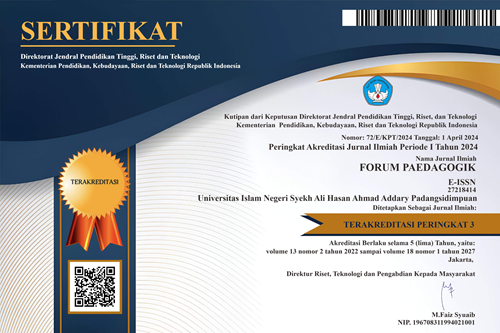EFFECTIVENESS OF INDIVIDUAL COUNSELING SERVICES USING A COGNITIVE BEHAVIOR THERAPY (CBT) APPROACH THROUGH DEEP SELF INSTRUCTION TECHNIQUES REDUCES LEARNING DIFFICULTY
The purpose of writing this article is to determine the effectiveness of individual counseling services using the Cognitive Behavior Therapy (CBT) approach through self-instruction techniques in reducing learning difficulties at Madrasah Aliyah Negeri 1 Medan. Quantitative research is guided by a pre-test plan and a single-group pre-test-post-test plan. On the analyst's learning difficulties scale, 26 of the 28 statement items are used in a test of legitimacy and firm quality. The results are considered substantial if the determined r exceeds the table r value, namely 0.2329 at a 5% level of significance. For the reliability test, Cronbroach alpha data was collected with a Cronbroach Alpha value greater than 0.05 (0.999 > 0.05). The research population at Madrasah Aliyah Negeri 1 Medan includes more than three classes in class X (ten), namely classes X5, X7, and X8. Purposive testing techniques were used to select five students with high levels of learning difficulties from 110 students in each of the three classes. The Wilcoxon Marked Positions Test was used to test the data. The results of this research show that the significance value is asymptotic. Sig(2-follow) values greater than 0.05 or 0.005 It is reasonable to assume that independent, individual tutoring services are effective in overcoming student learning difficulties.
Keywords : Individual Counselling; Difficulty learning; Cognitive Behavior Therapy.
- Cahyono, H. (2019). Factors of Min Janti Students' Learning Difficulties. Journal of Dimensions of Education and Learning, 7(1), 1. https://doi.org/10.24269/dpp.v7i1.1636
- Firmansyah, D., & Dede. (2022). Common Sampling Techniques in Research Methodology: Literature Review. Scientific Journal of Holistic Education (JIPH), 1(2), 85–114. https://doi.org/10.55927/jiph.v1i2.937
- Ghufron, MN, & Risnawita, R. (2015). Learning Difficulties in Children. Nurjati Press. http://isbn.perpusnas.go.id/Account/SearchBuku?searchCat=ISBN&searchTxt=978-602-9074-05-5
- Harahap, ACP, Selahap Sinaga, RN, Harahap, AD, Tanjung, DA, Fatimah, H., Putri, Z., & Nanda, NA (2020). 20232581 The Role of Media and Technology in Online Counseling Services to Improve the Mental Health of Binjai 7 Public High School Students. Didactics: PGSD STKIP Subang Scientific Journal, 09(July), 1–23.
- Haryatni, AP (2019). Identification of Factors Causing Learning Difficulties in Students of Ngeri 5 Middle School, Jambi City. Thesis.
- Hidayanti, SF, & Ja'far, M. (2019). The effectiveness of self-instruction and cognitive restructuring. Journal of Guidance Counseling, 5(1), 65–73. http://journal.unnes.ac.id/sju/index.php/jubk
- Hidayatulloh, S. (2017). Effectiveness of Individual Counseling Services using Self Instruction Techniques in Reducing Learning Burnout for Class I Awaliyah Madrasah Diniyah Islamic Boarding School Al-Hikmah Way Halim Bandar Lampung in the 2017-2018 Academic Year. Raden Intan Lampung State Islamic University.
- Mohammed. (2017). Learning Psychology. Medan Larispa Indonesia.
- Mz, I. (2018). The Role of Self-Concept in Student Discipline. NALAR: Journal of Islamic Civilization and Thought, 2(1), 1. https://doi.org/10.23971/njppi.v2i1.915
- Nurlela, E. (2019). The Effectiveness of Self-Instruction Techniques in Cognitive-Behavioral Counseling to Reduce Student Learning Saturation: Quasi-Experimental Research on Class VII Students of Tegaldatar One Roof Integrated Middle School, Purwakarta 2014-2015 Academic Year [Indonesian Education University]. http://repository.upi.edu/23029/%0A https://lens.org/034-224-376-311-795
- Nurmaliyah, F. (2024). Reducing students' academic stress by using self-instruction techniques. Journal of Humanities Education, 2(3), 273–282.
- Puspitasari, R. (2019). Instilling Environmental Care Character Values in Environmental Education Content in Social Sciences Learning at Mi Darul Hikam, Cirebon City. Al Ibtida: Journal of MI Teacher Education, 3(1), 39–56. https://doi.org/10.24235/al.ibtida.snj.v3i1.547
- Rahmadani, W., Harahap, F., & Gultom, T. (2017). Factor Analysis of Biology Learning Difficulties for Students with Biotechnology Material in Public High Schools in the City of Medan. Journal of Biology Education, 6(2), 279–285. https://doi.org/10.24114/jpb.v6i2.6546
- Sugiyono. (2010). Educational Research Methods (Quantitative, Qualitative and R&D Approaches). Al Fabeta.
- Suryani, YE (2019). Difficulty learning. Magistra Journal, 73, 33–47.
- Waruwu, H. (2019). Need for Student Learning Diagnosis. IKIP Gynungsitoli, 1(1), 116–126.
- Wicaksana, A., & Rachman, T. (2018). Factor Analysis of Students' Learning Difficulties in Improving Learning Outcomes in Sociology Subjects Class XII IPS at MA Syarif Hidayatullah Pontianak. Angewandte Chemie International Edition, 6(11), 951–952., 3(1), 10–27. https://medium.com/@arifwicaksanaa/pengertian-use-case-a7e576e1b6bf
 Copyright (c) 2024 Asbih Fahrezi Tanjung, Ade Chita Putri Harahap
Copyright (c) 2024 Asbih Fahrezi Tanjung, Ade Chita Putri Harahap

This work is licensed under a Creative Commons Attribution-ShareAlike 4.0 International License.











